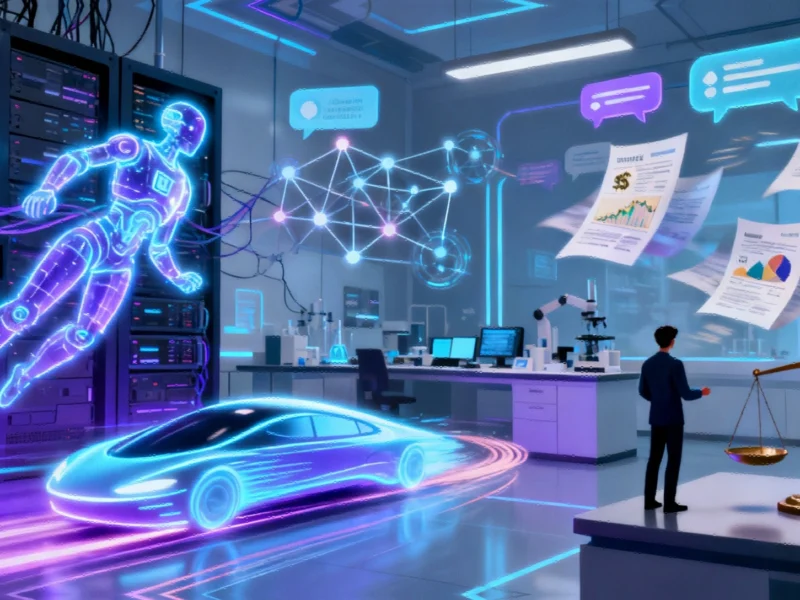AI Research Accelerates with New Haiku Model
The artificial intelligence landscape continues evolving at breakneck speed with Anthropic’s release of Claude Haiku 4.5 just two weeks after launching Claude Sonnet 4.5. This rapid development cycle underscores the intense competition in the AI research space, where companies are pushing to deliver increasingly capable models at lower costs. According to Anthropic’s latest performance metrics, the new Haiku model matches the coding capabilities of their previous flagship Sonnet 4 model while exceeding it in computer use tasks.
“Five months ago, Claude Sonnet 4 was a state-of-the-art model,” Anthropic stated in their official announcement. “Today, Claude Haiku 4.5 gives you similar levels of coding performance but at one-third the cost and more than twice the speed.” This dramatic improvement in efficiency has immediate practical implications, making applications like Claude for Chrome run significantly faster while opening new possibilities for real-time AI implementation.
Business Applications and Multi-Agent Workflows
For enterprise users, Haiku 4.5 introduces powerful capabilities for multi-agent workflows where multiple instances of the model can operate in parallel or collaborate with larger models. This architecture enables sophisticated task distribution where Sonnet 4.5—currently considered Anthropic’s premier model for AI agents—can plan complex projects while numerous Haiku 4.5 subagents rapidly execute individual tasks.
The model’s combination of speed and cost efficiency makes it particularly well-suited for real-time applications including advanced chatbots, customer service systems, financial analysis platforms, and research tools. This comes as global trade dynamics continue evolving and businesses seek competitive advantages through technological innovation.
The Human-Centered AI Imperative
As AI capabilities advance, the work of institutions like the Stanford Institute for Human-Centered Artificial Intelligence becomes increasingly critical. This interdisciplinary research institute, which gained prominence around 2020, focuses on developing and guiding AI in ways that prioritize human values, ethics, and societal benefit. What began as a conceptual framework has emerged as one of the most important themes of the 21st century, especially in the post-ChatGPT era where AI’s societal impact has become undeniable.
The ethical considerations extend beyond basic functionality to include how these systems are deployed globally, particularly as nations invest in sovereign data infrastructure to maintain control over their digital ecosystems.
Active vs Passive AI Engagement
Experts distinguish between active and passive approaches to AI utilization. The passive method involves asking AI to complete work and deliver final products, while the active approach treats AI as a collaborative thinking partner that helps extract knowledge and inspiration from the user themselves. Many professionals struggle to maintain productive thinking states long enough to develop quality ideas, and the process of “thinking through” complex problems requires sustained concentration that AI can help facilitate.
One AI researcher described using AI as a thinking partner that provides thoughtful, sometimes critical feedback to maintain engagement in deep cognitive work. This collaborative approach allows for more thorough examination of ideas that might initially seem promising but contain logical pitfalls upon closer inspection. Meanwhile, technology companies continue enhancing security features across their platforms to protect users in an increasingly digital world.
The Future of AI Development
As Anthropic and other AI developers continue refining their models, the focus remains on balancing capability with responsibility. The rapid iteration from Sonnet 4.5 to Haiku 4.5 demonstrates how quickly the field is advancing, while the emphasis on human-centered design principles ensures these technologies develop in ways that serve rather than supplant human intelligence.
The conversation around AI ethics and appropriate use cases—including content generation boundaries—will undoubtedly continue as these systems become more integrated into business operations and daily life. What remains clear is that the organizations successfully navigating this landscape will be those that leverage AI’s computational power while maintaining human oversight and ethical consideration.
Based on reporting by {‘uri’: ‘fastcompany.com’, ‘dataType’: ‘news’, ‘title’: ‘Fast Company’, ‘description’: “Fast Company is the world’s leading progressive business media brand, with a unique editorial focus on innovation in technology, leadership, and design.”, ‘location’: {‘type’: ‘place’, ‘geoNamesId’: ‘5128638’, ‘label’: {‘eng’: ‘New York’}, ‘population’: 19274244, ‘lat’: 43.00035, ‘long’: -75.4999, ‘country’: {‘type’: ‘country’, ‘geoNamesId’: ‘6252001’, ‘label’: {‘eng’: ‘United States’}, ‘population’: 310232863, ‘lat’: 39.76, ‘long’: -98.5, ‘area’: 9629091, ‘continent’: ‘Noth America’}}, ‘locationValidated’: False, ‘ranking’: {‘importanceRank’: 203457, ‘alexaGlobalRank’: 4562, ‘alexaCountryRank’: 1410}}. This article aggregates information from publicly available sources. All trademarks and copyrights belong to their respective owners.



